Philadelphia-born Titanic survivor Charlotte Drake Martinez Cardeza (1854-1939) is best known as the woman whose 14 steamer trunks were each full of fashionable frocks, hats, shoes, furs and jewelry. Of course, all that regalia went down with the ship while Charlotte survived in one of the first lifeboats launched, starboard Boat No. 3, wearing only a cotton nightgown and simple overcoat. A big game hunter and yachtswoman, the 58-year-old world traveler was more than athletically inclined — Charlotte believed in enjoying the luxury her wealth afforded. With her 36-year-old, poker-playing son, Thomas, his valet, Louis Lesueur, 35, and Charlotte’s maid, Annie Ward, 37, the rich divorcee booked one of the most opulent suites aboard Titanic, B-51-53-55. Just arriving from safari in Africa, the Cardeza party, sharing a ticket that cost Charlotte $3,200, boarded at Cherbourg on April 10th.
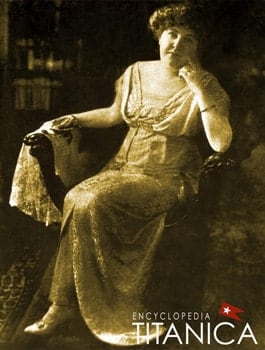
(Scott Memorial Library, Thomas Jefferson University)
Extravagant but generous, Charlotte was youthful for her age, turning heads with her superb fashion sense. Having such a gorgeous wardrobe, one might assume she tended to overdress but extant photos show a woman who chose her clothes with discernment. I have to wonder if Charlotte’s penchant for fashion stemmed from her own family’s association with the clothing industry. Her late father, Thomas Drake, made his fortune in the textile trade, owning a network of mills in England.
Self-assured, even commanding, Charlotte exuded a modishness considered showy by more restrained First Class passengers: she was to some the very definition of nouveau riche. Others felt her feeling for art and literature was that of a connoisseur. And whatever critics might say, her big-heartedness was admirable.
“There are a number of obnoxious, ostentatious American women,” famed Massachusetts-born artist Frank Millet wrote of some of his fellow travelers in a letter to a friend posted at Queenstown. Might he have seen Charlotte parading the decks in her Parisian finery? To him, these women were “the scourge of any place they infest and worse on shipboard than anywhere.”1
Though brisk and opinionated, Charlotte wasn’t the heavy-handed ogre some Titanic survivors seem to have indicated. As few women were as actively involved as she in big game hunting, a pastime she preferred to the social gatherings of her Philadelphia peers, Charlotte’s independent spirit and directness appear to have been misunderstood. Her Spanish names of “Martinez Cardeza” may also have attracted a whiff of the xenophobia then present in Anglo society. But it was mostly her take-charge nature that was insufficiently appreciated by other well-heeled Philadelphians. They considered her ill-bred despite a significant inheritance from her father, her devotion to charitable causes and a husband who was descended from Portuguese nobility.2
* * *
In examining Charlotte’s 20-page claim against The Oceanic Steam Navigation Co. for reimbursement of her lost possessions, one is struck not only by the minutia of items listed but the exceedingly lavish manner in which this extraordinary globetrotter dressed. She was a typical Edwardian lady — tough-willed, outspoken and adventuresome yet daintily feminine in her sartorial ways. The woman who spent excessively but gave just as freely, fastidiously asked for compensation for even her smallest losses — collarbones for blouses, shoe laces, ribbons, combs and flower ornaments for her hair.3
Her Wall Street lawyers, Shearman and Sterling, in their December 1912 filing, itemized every glove, hat pin and shoe buckle in dizzying detail: each pin was made of different jewels. Even salt shakers she was bringing back from her European holiday were gold-embossed. The cost quoted for merchandise was somewhat higher than normal for the time, especially in the case of Charlotte’s custom clothing, but this may be explained by the fact that couturiers regularly inflated prices for their wealthiest customers. Either that, or Charlotte and her attorneys padded the prices themselves.

She wears an afternoon dress from one of Lucile’s 1911-12 collections called “Dinna Forget Me,” after a Scottish poem.
(Scott Memorial Library, Thomas Jefferson University/Randy Bryan Bigham)
Charlotte was at an age when most women dressed conservatively, but she took advantage of her young looks and always wore the latest styles. From Charlotte’s nearly $178,000 petition, the largest claim for material losses filed after the Titanic disaster, we learn clues about her taste. The first thing that struck me was how much Charlotte liked polka dots; many of her dresses were in that pattern in various materials and colors. Also, she was fond of diamonds — in necklaces, rings, brooches, bracelets, evening headwear.
Charlotte could afford the best in fashion and she had it, many of her clothes coming from the leading designer salons and department stores of London, Paris and New York. In addition to buying knickknacks in Florence, Lucerne, Vienna, Carlsbad, Dresden and Berlin, she was a devoted client of the Paris couture houses Redfern and Rouff. In London, she went to Lucile. In America, her favored shops included Lord & Taylor, Saks, B. Altman and Wanamaker. Charlotte also frequented the Bon Marche shops in Paris.
Reading the list is almost as exciting to a dress historian as opening one of Charlotte’s Vuitton, Goyard or Innovation trunks. We see that she owned some of the most expensive furs – ermine, chinchilla and silver fox. She also had mink, moleskin, squirrel, seal and baby lamb. Her diamonds and other jewels were from Tiffany. She had with her every conceivable gem – opals, sapphires, emeralds. A lace-edged feather fan she listed was encrusted with mother of pearl. The most expensive item of jewelry Charlotte lost was a $20,000 pink diamond pendant; the next priciest, a $14,000 ruby ring.

(National Archives)
There’s an extensive list of veils and feather pieces for her hats, many of which were made by Valette of Paris. Chinchilla and ermine were also favorites for millinery trimming as she had several hats edged with bands of those furs. Descriptions of the hats are a delight – she mostly preferred velvet ones in various styles. Some of the prettiest-sounding were a “light blue velvet hat with pink roses,” a “mauve hat with ostrich feathers” and a “champagne straw hat with pink ostrich feathers.” All these were from Valette.
The shoes list rivals the rest. Among her dozens of shoes was a purple satin pair as well as a pair of green evening pumps with stockings to match. Charlotte also listed a pair of “light blue satin slippers” with matching stockings. Skirts were narrow and ankle length in 1912, but when a lady was seated her feet and ankles often showed, particularly when she crossed her legs at the knees, a once daring posture but now often observed in public among the most chic women. Shoes and stockings were therefore more important than they had been in previous years when full skirts touched the ground, covering legs completely. Other shoes detailed in the claim included a black satin pair of pumps with pink roses over the toes and a white fur-trimmed pair of quilted pink satin boudoir mules.

(National Archives)
* * *
Some descriptions of Charlotte’s clothes are mouthwatering to a lover of period fashion. We find that even her corsets came from her beloved Redfern, and I note that she also had a white appliqué parasol from this designer. Her Redfern and Rouff clothes were especially sumptuous. An evening gown from Redfern was described as “iridescent spangled net” and priced at $480, an enormous sum in those days. A pair of Rouff under-drawers with matching corset cover was made of antique lace embroidered with butterflies and floral wreaths. A Redfern day dress of broadcloth was trimmed in Venetian lace and cost $500, one of the most expensive items of fashionable apparel listed.
Which of these lovely dresses were worn on Titanic may never be known, but the imagination ignites as one reads of Charlotte’s tailored suits, afternoon dresses, dinner gowns, evening cloaks, sports attire and lingerie. Evidence of Charlotte’s following the prevailing line in fashion is seen in her reference to a white net and embroidered lace tunic surmounting a pink silk “hobble” skirt. The dress was from Lord & Taylor and cost $400. Might she have worn this to relax with refreshments in the Palm Court or meet friends in the Louis XV-decorated lounge?
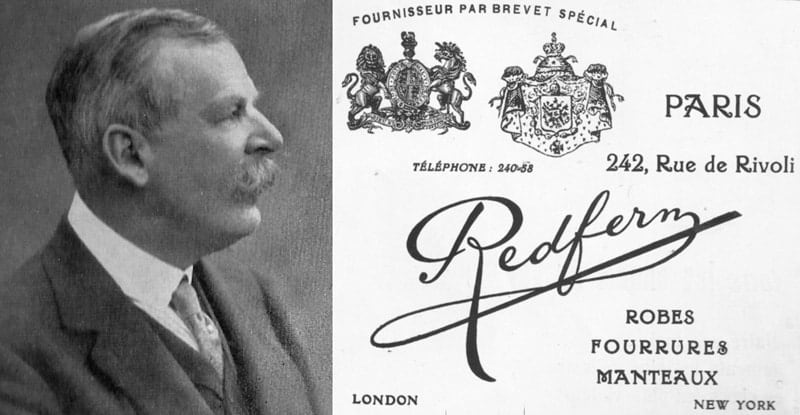

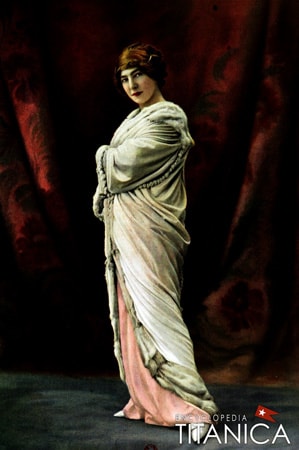
The Redfern cape had been featured in a spring 1912 issue of Les Modes magazine.
What, one wonders, did she wear when her son gave card parties on their private promenade deck, entertaining, among others, Broadway producer Henry B. Harris and his wife, René, early in the evening of April 14th.4 Maybe she wore the blue satin tea-gown that she’d bought in Vienna. She might later have changed into a lace-collared pink dressing gown from Rouff as she dressed her hair for dinner that night. With the chill air, might she have worn her new Redfern evening cape? A similar design had just been featured in a recent issue of the Paris fashion magazine Les Modes.5 Whatever she chose, it was expensive.
Even small accessories were extraordinarily valuable. Women covered their shoulders in the evening with beautiful scarfs and one of Charlotte’s (from Lord & Taylor), in pink silk trimmed with marabou, cost $55. The inventory of her lost garments, adjuncts and jewels included beaded purses, gem-studded opera glasses, monogramed lace handkerchiefs. Even her embroidered satin pillow cases came from Rouff.
But Charlotte believed in spreading her fashion patronage around, commissioning other important designers to make her garments. We discover she bought a black and green lace dress from Worth for $900, the highest-priced garment listed, and two items from Lucile of London: a “rose gown” for $350 and a “white satin petticoat with lace and flowers” for $200.
One wonders if Charlotte, as she walked the promenade deck or entered Titanic’s French restaurant, recognized Lucile (Lady Duff Gordon) herself in the crowd of fellow travelers on that fateful voyage. Undoubtedly, Lucile noticed Charlotte in her polka dots and feathers, and must have approved of her open love for fashion and the confident sense of personal style she exhibited.
* * *
Yet on that night of nights, April 14th, the Edwardian fashionista who doted on designer clothes and baubles from Tiffany, made her escape in a conventional motor coat over a negligée of pink-trimmed white lawn (a kind of sheer cloth), leaving behind her exquisite furs and sequined gowns. The nightdress was recently auctioned for over $40,000.6 Heading home to seek medical advice for her ailing son, Charlotte’s maternal instinct extended now to her maid and her son’s manservant as she led her little party topside. They’d been awakened earlier by the iceberg collision and gone on deck to investigate, but on being told by crewmen there was nothing amiss, the group had returned to their beds. Now Charlotte was taking no chances.
Not bothering to dress, perhaps for the first time in her stylish life, Charlotte urged her maid, Annie Ward, to hurry. As the foursome left their B Deck suite, Annie tucked some valuables in her coat pockets, including two of the salt shakers her employer had recently bought. She later assured Charlotte she’d saved them but was told to keep the trinkets.7
Mounting the main staircase to the Boat Deck as they’d been instructed, Charlotte, Thomas, Louis and Annie exited the foyer on the starboard side and waited with others in the cold and noise – the funnels were blowing off steam and the roar was deafening. Two lifeboats were soon loaded and lowered and when an officer called for people to enter Boat 3, the Cardezas and their employees stepped forward.
At 12:55 a.m., just over an hour after the collision, No. 3 began lowering to the sea an estimated 50 feet below. In a lifeboat built to carry 65 occupants, there were only about 32 men and women aboard.8 Nothing conclusive is known of the Cardezas’ experiences in the lifeboat although a fellow First Class passenger, Daisy Corning Stone Spedden, is thought to have been describing Charlotte when she mentioned an irritating woman who kept ordering people around.9 I question this, though, as the offending female was described as “fat” and, while Charlotte does not appear reed-thin in her 1912 photos, she was not significantly overweight; only her face appears slightly plump. Another woman aboard Boat 3, Elizabeth Shutes, may have been referencing Thomas and his valet when she told of two men who continued smoking cigars after they were asked to stop.10

(Bonhams)
Charlotte never publicly spoke of the disaster, and when Thomas and Annie were later interviewed, they gave only brief accounts.11 Undoubtedly Charlotte, accustomed to being in charge, remained resolute throughout the emergency and made some attempt to be of service. Although cold and nervous, she kept focused and cheerful, trying to encourage Annie and those around them. Whether Charlotte was helpful or bothersome to her mid-ocean companions, she managed to acquire the numeral 3 off the lifeboat and that relic survives today in the library archives of Thomas Jefferson University.
Annie recalled that Charlotte held her hand throughout the ordeal of April 15th. In that time of horror, those same clasped hands had earlier packed away the luscious silks and satins, fluffy feathers and sparkling diamonds that they’d never see again. But as their lives had been spared, it was gratitude that filled their hearts now. On the morning Titanic went down, Charlotte’s 14 trunks of costly glory suddenly meant very little.
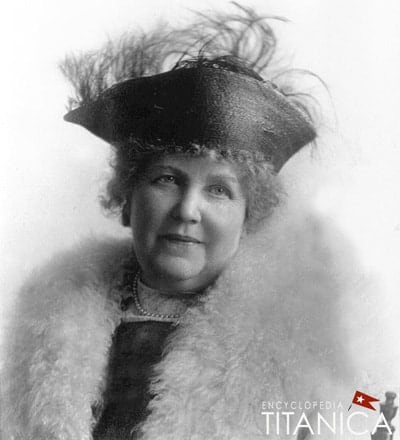
(National Archives)

(Janet Kunz, Encyclopedia Titanica)
Acknowledgements
Thanks first of all to Gregg Jasper and Mike Poirier for their suggestions. Thanks are also owed to Leighton Hammond Coleman III, great nephew of Daisy Spedden, for his information and advice. I am grateful, too, to the archives of the Scott Memorial Library of Thomas Jefferson University for providing portraits of Charlotte Martinez Cardeza. Finally, my appreciation goes to Miles Hamilton Lehmann for his support, Jordan Tancesvski and Titanic Animations for use of the digital image of Titanic sinking and Phil Hind of Encyclopedia-Titanica for permission to include other rare images.
Unless otherwise noted, images were provided by Randy Bryan Bigham
Notes
- Sharpley-Schafer, Joyce, Soldier of Fortune: F. D. Millet, 1846-1912, J. A. Sharpley-Schafer, 1984, pp. 150-151.
- Hauschild, John, “Titanic People, Titanic Life: A Woman of the ‘90s - Charlotte Drake Martinez Cardeza,” The Titanic Commutator (Titanic Historical Society), Vol. 17, No. 1, May-July 1993, pp.68-72.
- Claim of Charlotte D. M. Cardeza; 1912; In the Matter of the Petition of the Oceanic Steam Navigation Company, Limited, for Limitation of its Liability as owner of the steamship Titanic; Admiralty Case Files, 1790 - 1966; Records of District Courts of the United States, ; National Archives, New York, NY.
- Harris, Renée, “My Husband Went Down with the Titanic,” Liberty, April 23, 1932, pp. 26-32; letter from Renée Harris to Gregg Jasper, Dec. 6, 1967.
- Les Modes, “Habilee par Redfern,” Feb. 1912, p. 9
- Bonhams, June 28, 2022.
- Philadelphia North American, April 25, 1912. Contributed by Mike Poirier
- Halpern, Samuel, ed, Report into the Loss of the SS Titanic, Gloucestershire (UK): The History Press, 2016., p. 137.
- Undated letter in the possession of Daisy Corning Spedden’s family and reproduced in Titanic: Women and Children First by Judith Geller (New York: W. W. Norton Co., 1998). P. 73. Thanks to Leighton Hammond Coleman III.
- Gracie, Archibald, The Truth about the Titanic, New York: Mitchell Kennerley, 1913, p. 258. Thanks to Gregg Jasper.
- New York Sun, April 27, 1912; “The Accounts of the master and the maid,” Voyage (Titanic International Society) Vol. 114, Winter 2021, p. 61. Contributed by Mike Poirier
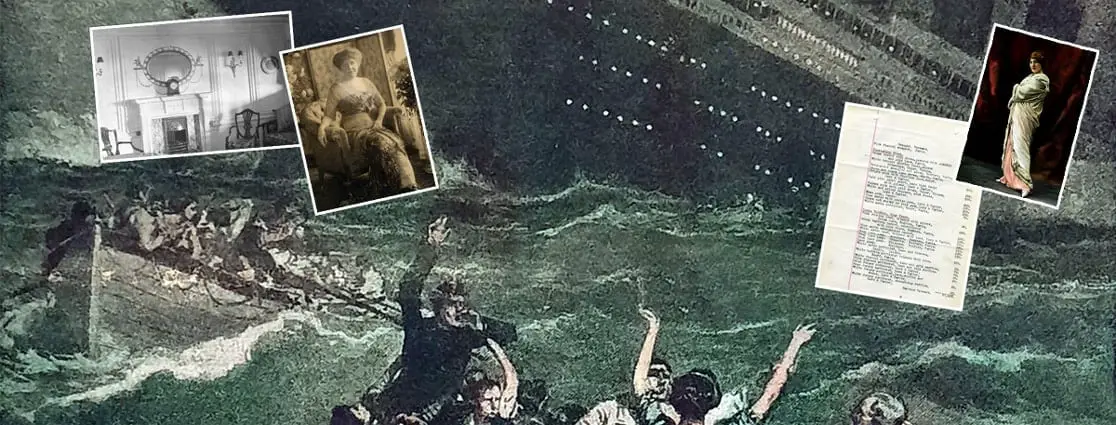

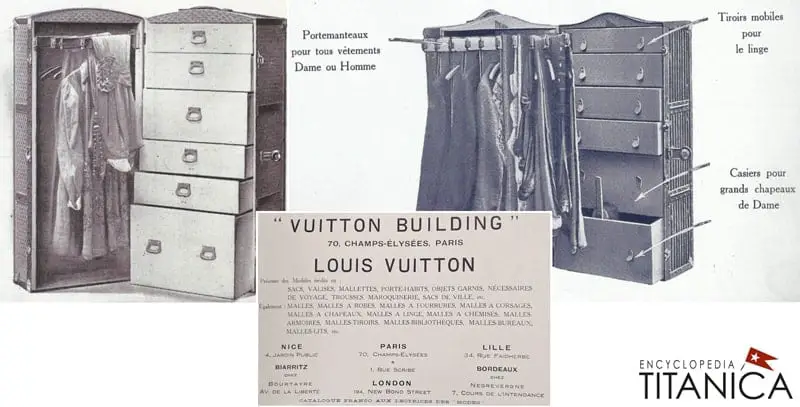
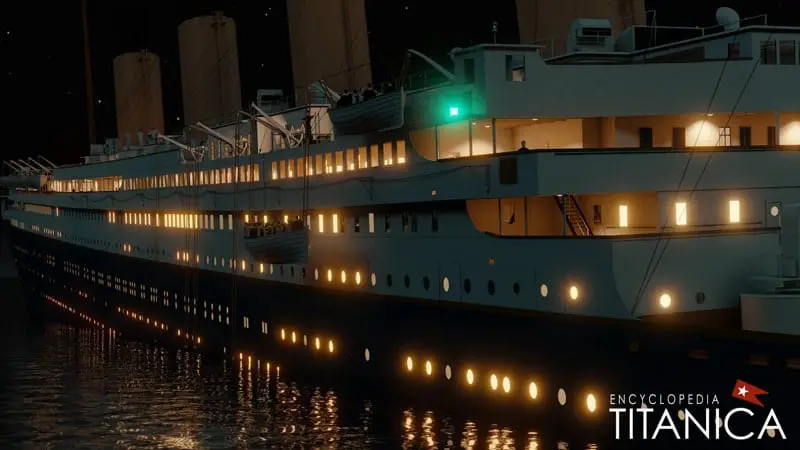

Comment and discuss